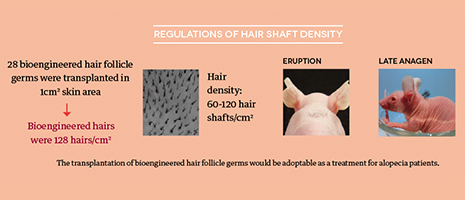Home > Highlighting JAPAN > Highlighting Japan October 2018 > Science & Technology
Highlighting JAPAN


The Future of Regenerative Medicine for Hair Follicles
Organ Technologies and RIKEN have developed large-scale technology that stimulates hair follicles to produce hair, and have begun preclinical safety tests on a potential cure for the plague of baldness.
Regenerative medicine employs stem cells, which can generate differentiated cells for various systems and organs of the body and restore functions lost due to disease or injury. Researchers have recently been able to artificially create multiple types of stem cells, and related research is progressing worldwide. The end goal is to use the right signals to manipulate stem cells into regenerating various organs such as kidneys and hearts. Among the countries engaged in this research, Japan’s technology shines, and in fact Japan has produced many kinds of organoids (mini-organs cultivated from stem cells in a test tube).
Expectations are high for research on regenerative medicine, which is slated to become the next major evolution in medical treatment. The first generation of regenerative medicine involved introducing stem cells into the body as a treatment, and the second generation was artificially regenerating tissues. The current generation of regenerative therapy is highly focused on three-dimensional organ regeneration. The organ regeneration team at RIKEN’s Center for Biosystems Dynamics Research, led by Dr. Takashi Tsuji, was the first to regenerate teeth, hair follicles, and salivary and tear glands. In June of this year, RIKEN and Organ Technologies began preclinical testing of a hair-loss cure that uses a hair follicle that grows hair in cycles. They hope to use the world’s first regenerated organ treatment to launch Japan’s regenerative medicine industry.
“Male pattern baldness afflicts approximately eighteen million men in Japan, and the healthcare market for products to treat thinning hair and baldness is 440 billion yen ($4 billion),” Tsuji says. “People’s interest is high, and because it’s such a huge, wide-ranging industry, with everything from hair-growth products to surgical hair follicle transplant treatments, we’d like to develop products that have a scientific basis and improve quality of life.”
The road from research and development to preclinical testing was not easy. There were not many hair follicles available, and it took seven years to increase the number of hair follicle anlage (an organ or tissue in its earliest recognizable stage of development) for practical application via stem cells. Manufacturing the anlages was done by hand on a micro scale, but they were able to achieve stable mass production by working jointly with other companies. To keep hair growing and stop the pores from closing, thin nylon fibers are inserted, which also enabled them to regulate hair density.
At the same time, Yasuhiro Sugimura, the president of Organ Technologies who is tasked with developing the business side of hair follicle regenerative medicine technology, stresses the importance of creating the regenerative medicine industry on the free market, away from any national finance pressures. Organ Technologies aims for regenerative medicine to be applied not just to cure disease but also as pre-symptomatic or preventive care, a wellness innovation that will prolong healthy lives in an aging society.
Regenerative medicine is at the core of twenty-first century medical treatment and it is strategically important for Japan to develop this high-value industry.
“We pursue innovations in this area of research and development at a world-class level, and it is our mission to make it happen both within and beyond Japan,” Tsuji and Sugimura agree. “Regenerating hair follicles is the beginning of that road, and after preclinical and safety testing our goal is to implement it by 2020. Starting by curing baldness, our intention is to develop an industry aimed at improving quality of life.”
© 2009 Cabinet Office, Government of Japan







